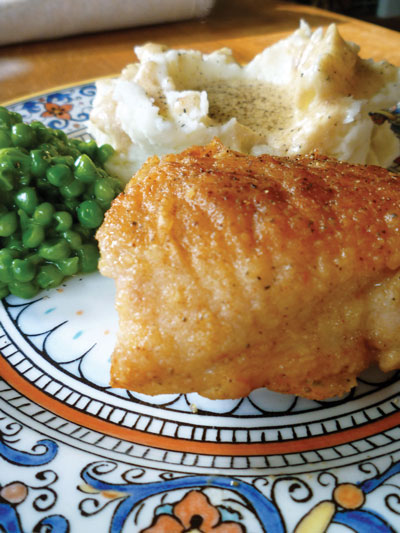
I was young when my mother passed away, so my father’s girlfriend, Kickie, has been a second mom and an important figure in my adult life. After my father passed in 2008, we grew even closer. She visits for four weeks during the holidays, and I make regular pilgrimages to visit her in my homeland, the Silicon Valley.
Kickie grew up in the hills of Kentucky, where as the oldest of 11 children, cooking became her responsibility early on, from making biscuits (standing on an old milk bucket to reach the counter) to learning her grandmother “mammy’s” recipe for fried chicken at age eight. And she’s been making it the same way for 75 years.
Having a fried chicken addiction, I’ve sampled it across the country since childhood. I even wrote an article (“Fried Chicken Frenzy,” June 2005) detailing my choices for the Bay Area’s best fried chicken. But of all I’ve tried, Kickie makes the best I’ve eaten anywhere.
Making it in a pan like she does is much harder than it looks. It’s a labor of love, trial and error, and something passed down to generations. I feel lucky and honored to be the one to whom Kickie chose to pass on her family recipe. I’ve observed, asked questions, taken notes, and gone home to make it on my own, where I fretted, failed, and yes, even cried. This summer I asked Kickie her secret. “I’ve made it so many times I just know,” she said.
Finally I started to get the hang of it, and Kickie felt confident enough to stand back for the most part and let me do the work. It was daunting at first, but suddenly it clicked, and there it was: perfectly pan-fried chicken, juicy inside, crunchy outside, and not a bit greasy.
Recently I made it solo at home, and for the first time, it was nearly perfect. I was prouder of making a successful batch of Kickie Fried Chicken (or, as I call it, “the real KFC”) than I was of all the fancy recipes I’ve ever mastered.
Kickie Fried Chicken
(the real KFC)
Serves 2 to 3
1 fresh, free-range chicken, cut into parts (I use Mary’s air-chilled chicken, and it does make a difference. The flavor and texture is far superior to factory-farmed or frozen chicken parts).
Peanut oil (preferred for its high-smoke point, but you can use regular vegetable oil)
2 eggs
2 tablespoons margarine (Kickie swears by Imperial brand)
2 cups all-purpose flour
Cayenne pepper, kosher salt, and black pepper to taste
Pat chicken dry with paper towels, cut breast in half (so it cooks evenly with the other parts). Set pieces on a platter and bring to room temperature. (Wash your hands with soap and hot water and clean thoroughly any surface touched by the raw chicken.)
Set two large, wide bowls side-by-side. Beat eggs with one teaspoon water in first bowl. Combine flour and spices in second bowl.
Pour ½-inch oil in a 10–12 inch sauté pan and bring to medium-high heat.
Dip the chicken parts in egg wash, shaking off excess, and then roll in the flour mixture to completely cover chicken in a thin layer; set on a plate next to your pan.
When the oil “shimmers” (drop a bit of flour in the oil – if it sizzles and small bubbles form, it’s ready), lay chicken parts in pan, skin side up, and cook for 5 minutes.

Using a fork (like Kickie does) or tongs, gently lift pieces and check color: When they are golden brown, turn them skin-side down and cook for another 5 minutes. Adjust heat as necessary (you should have a uniform oil sizzle throughout).
Using fork or tongs, hold each piece on its side and cook for about 10 seconds per side, or until all four sides are golden brown; then lay pieces skin-side up, add the margarine, cover pan, and turn heat to low. Cook for 10 minutes, occasionally lifting the lid to allow condensation to drip onto chicken.
Uncover pan, turn heat back to medium high and cook another 10 minutes, until juices run clear or an instant-read thermometer registers 165 degrees.
Let rest for several minutes before serving. The crust should be, as Kickie says, “crunchy and gooey brown” and the inside will be moist and juicy.
For sides, Kickie serves peas and mashed potatoes with country gravy made from the pan drippings, a roux and milk – but good country gravy is a whole other column.








